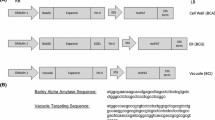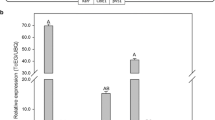Abstract
The cost of enzymes that hydrolyse lignocellulosic substrates to fermentable sugars needs to be reduced to make cellulosic ethanol a cost-competitive liquid transport fuel. Sugarcane is a perennial crop and the successful integration of cellulase transgenes into the sugarcane production system requires that transgene expression is stable in the ratoon. Herein, we compared the accumulation of recombinant fungal cellobiohydrolase I (CBH I), fungal cellobiohydrolase II (CBH II), and bacterial endoglucanase (EG) in the leaves of mature, initial transgenic sugarcane plants and their mature ratoon. Mature ratoon events containing equivalent or elevated levels of active CBH I, CBH II, and EG in the leaves were identified. Further, we have demonstrated that recombinant fungal CBH I and CBH II can resist proteolysis during sugarcane leaf senescence, while bacterial EG cannot. These results demonstrate the stability of cellulase enzyme transgene expression in transgenic sugarcane and the utility of sugarcane as a biofactory crop for production of cellulases.




Similar content being viewed by others
References
Sousa, L. D., Chundawat, S. P. S., Balan, V., & Dale, B. E. (2009). ‘Cradle-to-grave’ assessment of existing lignocellulose pretreatment technologies. Current Opinion Biotechnology, 20, 339–347.
Sainz, M. B. (2009). Commercial cellulosic ethanol: The role of plant-expressed enzymes. In Vitro Cellular & Developmental Biology—Plant, 45, 314–329.
Klein-Marcuschamer, D., Oleskowicz-Popiel, P., Simmons, B. A., & Blanch, H. W. (2012). The challenge of enzyme cost in the production of lignocellulosic biofuels. Biotechnology and Bioengineering, 109, 1083–1087.
Aden, A., Davis, R., Dudgeon, D., Hsu, D., Humbird, D., Kinchin, C., et al. (2011). Process design and economics for biochemical conversion of lignocellulosic biomass to ethanol: Dilute-acid pretreatment and enzymatic hydrolysis of corn stover. National Renewable Energy Laboratory. Technical Report NREL/TP-5100-47764.
Stephen, J. D., Mabee, W. E., & Saddler, J. N. (2012). Will second-generation ethanol be able to compete with first-generation ethanol? Opportunities for cost reduction. Biofuels, Bioproducts and Biorefining, 6, 159–176.
Harrison, M. D., Geijskes, J., Coleman, H. D., Shand, K., Kinkema, M., Palupe, A., et al. (2011). Accumulation of recombinant cellobiohydrolase and endoglucanase in the leaves of mature transgenic sugar cane. Plant Biotechnology Journal, 9, 884–896.
Food and Agriculture Organization of the United Nations, FAOSTAT database (FAOSTAT 2012). Retrieved from http://faostat.fao.org/site/291/default.aspx.
Bull, T. (2000). The sugarcane plant. In D. M. Hogarth & P. G. Allsopp (Eds.), Manual of cane growing (pp. 71–83). Brisbane: Bureau of Sugar Experiment Stations.
Willcox, T., Garside, A., & Braunack, M. (2000). The sugarcane cropping system. In D. M. Hogarth & P. G. Allsopp (Eds.), Manual of cane growing (pp. 127–139). Brisbane: Bureau of Sugar Experiment Stations.
Taylor, L. E., Dai, Z. Y., Decker, S. R., Brunecky, R., Adney, W. S., Ding, S. Y., et al. (2008). Heterologous expression of glycosyl hydrolases in planta: A new departure for biofuels. Trends in Biotechnology, 26, 413–424.
Jeoh, T., Michener, W., Himmel, M. E., Decker, S. R., & Adney, W. S. (2008). Implications of cellobiohydrolase glycosylation for use in biomass conversion. Biotechnology for Biofuels, 1, 10.
Birch, R. G., Bower, R. S., & Elliott, A. R. (2010). Highly efficient, 5′-sequence specific transgene silencing in a complex polyploid. Tropical Plant Biology, 3, 88–97.
Mudge, S. R., Osabe, K., Casu, R. E., Bonnett, G. D., Manners, J. M., & Birch, R. G. (2009). Efficient silencing of reporter transgenes coupled to known functional promoters in sugarcane, a highly polyploid crop species. Planta, 229, 549–558.
Wei, H. R., Wang, M. L., Moore, P. H., & Albert, H. H. (2003). Comparative expression analysis of two sugarcane polyubiquitin promoters and flanking sequences in transgenic plants. Journal of Plant Physiology, 160, 1241–1251.
Hassuani, S. J., Leal, M. R. L. V., & Macedo, I. C. (2005). Biomass power generation: Sugar cane bagasse and trash. In Série Caminhos para Sustentabilidade, vol. 1, PNUD—Programa das Nações Unidas para o Desenvolvimento, CTC—Centro de Tecnologia Canavieira.
Kent, G. A. (2007). The effect of trash on the operation and performance of a raw sugar factory. Proceedings of the Annual Congress of the South African Sugar Technologists’ Association, 26, 1622–1628.
Thorburn, P. J., Archer, A. A., Hobson, P. A., Higgins, A. J., Sandel, G. R., Prestwidge, D. B., et al. (2006). Integrated value chain scenarios for enhanced mill region profitability. Sugar Research and Development Corporation, Report CSE010.
Matsuoka, M., Kyozuka, J., Shimamoto, K., & Kanomurakami, Y. (1994). The promoters of 2 carboxylases in a C-4 plant (maize) direct cell-specific, light-regulated expression in a C-3 plant (rice). Plant Journal, 6, 311–319.
de Virgilio, M., De Marchis, F., Bellucci, M., Mainieri, D., Rossi, M., Benvenuto, E., et al. (2008). The human immunodeficiency virus antigen Nef forms protein bodies in leaves of transgenic tobacco when fused to zeolin. Journal of Experimental Botany, 59, 2815–2829.
Geli, M. I., Torrent, M., & Ludevid, D. (1994). Two structural domains mediate two sequential events in γ-zein targeting: protein endoplasmic reticulum retention and protein body formation. Plant Cell, 6, 1911–1922.
Cervelli, M., Di Caro, O., Di Penta, A., Angelini, R., Federico, R., Vitale, A., et al. (2004). A novel C-terminal sequence from barley polyamine oxidase is a vacuolar sorting signal. Plant Journal, 40, 410–418.
Jakowitsch, J., NeumannSpallart, C., Ma, Y., Steiner, J., Schenk, H. E. A., Bohnert, H. J., et al. (1996). In vitro import of pre-ferredoxin-NADP(+)-oxidoreductase from Cyanophora paradoxa into cyanelles and into pea chloroplasts. FEBS Letters, 381, 153–155.
Miles, S. (2009). High level expression and accumulation of heterologous polypeptide in plant tissue. US patent application serial No. 2009/099783, filed January 26, 2009.
Acknowledgments
The authors are grateful to Paul Oeller, Jason Nichols, Kerry Kaffall, and Sergio Arellano at Syngenta Biotechnology Incorporated for providing anti-cellulase antibodies, denatured positive control proteins for western blotting, and for helpful discussions. The authors thank William Doherty for providing valuable comments on the manuscript. The authors also thank the staff at the Queensland Crop Development Facility (Department of Agriculture, Fisheries and Forestry, Queensland State Government) for their assistance with the growth of transgenic sugarcane. Mark Harrison was the recipient of a Smart State Fellowship from the Queensland State Government. The Queensland Crop Development Facility was funded by a grant from the Smart State Research Facilities Fund Scheme of the Queensland State Government. The Syngenta Centre for Sugarcane Biofuels Development is supported by Syngenta Biotechnology Incorporated, Queensland University of Technology, Leaf Energy Ltd., and by a grant from the National and International Research Alliances Program of the Queensland State Government.
Author information
Authors and Affiliations
Corresponding author
Rights and permissions
About this article
Cite this article
Harrison, M.D., Geijskes, R.J., Lloyd, R. et al. Recombinant Cellulase Accumulation in the Leaves of Mature, Vegetatively Propagated Transgenic Sugarcane. Mol Biotechnol 56, 795–802 (2014). https://doi.org/10.1007/s12033-014-9758-9
Published:
Issue Date:
DOI: https://doi.org/10.1007/s12033-014-9758-9




